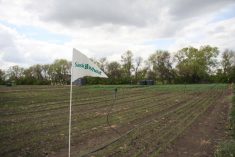If you are concerned about the all-important nitrogen losses due to environmental factors, there are several solutions in the form of nitrogen stabilizing or Enhanced Efficiency Fertilizer (EEF) products to choose from.
All can be quite effective according to private, government and university researchers, but along comes the big depends. It depends on moisture conditions, it depends on soil types, and it depends on the type of nitrogen loss you are trying to prevent or at least reduce.
There are three main types of nitrogen losses due to environmental factors:
Read Also

Cancer agency reclassifies another herbicide ‘probably carcinogenic’
The WHO’s cancer research agency has now put atrazine, a herbicide well known to corn growers, in the same potential-hazard category where the agency put glyphosate.
1. Volatilization: This happens most commonly when nitrogen, such as granular urea is broadcast or surface applied. If moisture doesn’t come along within a couple days after application to move the nitrogen into the soil, nitrogen can begin to be released to the atmosphere. Research in this area shows that as much as 40 per cent of N can be lost to volatilization. And it’s been found too, even shallow banded nitrogen — in the top 1-1/2 inches of soil — can also be subject to volatilization losses.
2. Dentrification: This is a gassing-off process when nitrogen sits in wet or waterlogged soil. The N begins to breakdown, is converted to nitrate form and again can be lost to the atmosphere. Researchers report on a nice warm 25 C day, with wet soils as much as four to five pounds of N can be lost per day.
3. Leaching: This loss is most common on coarse, sandy soils exposed to moisture. The nitrogen, again converted to a nitrate form is essentially flushed down out of the crop root zone.
Dealing with losses
So how do you deal with these potential losses? There are several EEF products on the market. All have been shown to be effective — qualifier, under certain conditions. Some are developed and promoted to help prevent all three types of nitrogen losses, others are more specific.
There are two main EEF types, with different modes of actions of importance to Western Canadian farmers. There is the polymer-coated urea EEF product that throws a protective wrap around a urea granule. Moisture can permeate in to dissolve the nitrogen inside the coating, but it is temperature sensitive, so the nitrogen won’t permeate out until soil temperatures rise. Then it is gradually released over 50 to 80 days. ESN (Environmentally Smart Nitrogen) marketed by Nutrien (formerly Agrium) is a brand name most familiar to Prairie producers. It is marketed to be effective against all three types of nitrogen losses.
The second category is nitrogen-loss inhibitor products, and there are several on the market. Depending on the product, they are designed to work with granular urea, anhydrous ammonia and liquid fertilizer formulations. The inhibitor products essentially kill or temporarily disable soil enzymes responsible for breaking down nitrogen in the soil, which under wet (waterlogged) soil conditions can lead to nitrogen being lost in a process known as denitrication. Nitrogen breakdown is slowed, not eliminated, until growing conditions warm up. The enzymes repopulate themselves, the nitrogen breakdown process resumes, making nitrogen available to the plant roots. Common brand names among the inhibitors are products such as Agrotain and SuperU, both marketed by Koch Fertilizers, and N-Serve and eNtrench products, marketed by Dow AgroSciences.
Agrotain is a urease enzyme inhibitor applied to urea granules, which help to reduce the risk of nitrogen being lost through volatilization.
ENtrench, N-Serve and SuperU work similarly to the urease inhibitor but at a different phase of the N-cycle. These nitrification inhibitors are chemicals that reduce the rate at which ammonium is converted to nitrate by killing or interfering with the metabolism of Nitrosomonas bacteria. Nitrogen is quite stable in the ammonium form, but with the combination of moisture and warming temperatures eventually it converts to nitrite and then to nitrate. And in the nitrate form it is vulnerable to leaching and nitrification losses.
SuperU is actually a combination product. It contains both urease and nitrification inhibitors which can work at all levels to reduce the risk of denitrification, leaching and volatilization.
Points to consider
Agronomists make a couple of important points. First understand the nitrogen cycle to learn where nitrogen losses occur. If you do an on-line search of “nitrogen cycle” there are many excellent graphics showing just how the process works. Understand the cycle, then ask “what is your risk factor of these losses occurring?” If you are applying urea through fall broadcast, or the seedbed is commonly soaked every year, or you’re farming sandy soil, for example, your risk of loss may be quite high. On the other hand, if over the past 10 years high-risk conditions have presented only once or twice, overall your losses could be low.
Companies say, depending on the product, there are several benefits to EEF products ranging from increased seeding efficiency, reduced input costs, to higher yields. By applying nitrogen ahead of the seeding operation, Koch Agronomy Services found equipment could seed 40 per cent more acres than the same equipment being used to apply nitrogen at time of seeding. In some SuperU trials they found they could use SuperU at 70 per cent of the recommended fertilizer rate and achieve the same yields.
Nutrien reports that ESN can produce a 3:1 return on investment with canola (for every dollar spent on the product it will return a $3 net return through higher yields). With wheat, they report a return between 2.5:1 to 3:1. It is also seed safe — all nitrogen can be applied in the seed row without seed damage.
Dow AgroScience reports that crops grown where nitrogen was protected with their N-Serve and eNtrench products yielded higher — 3.8 bushels per acre for canola and 3.7 bu./ac. for spring wheat/durum.
















